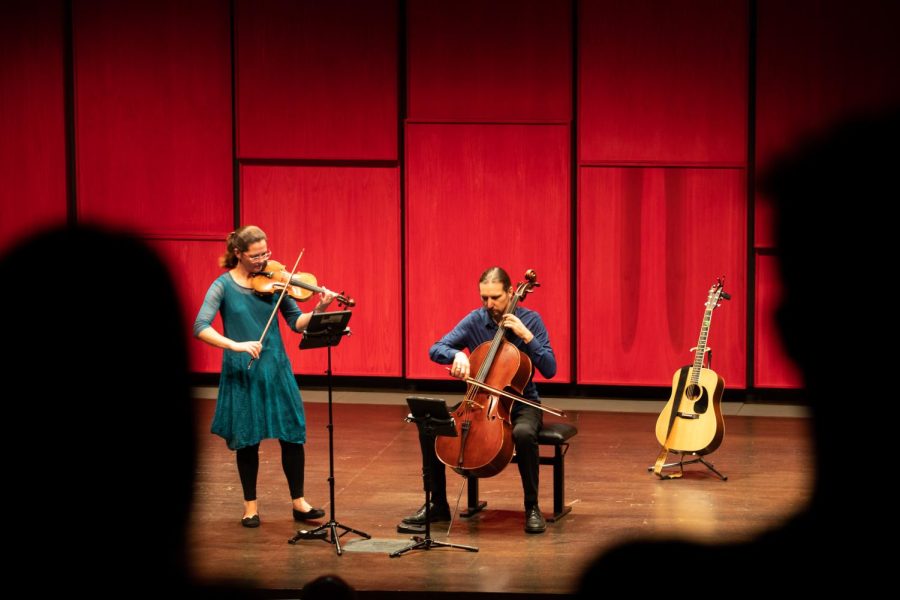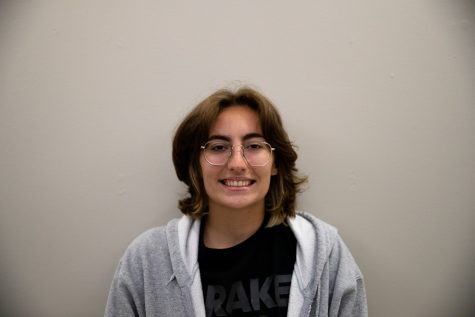Review | Larksgrove Ensemble gives captivating performance at Voxman
The Larksgrove Ensemble performed a beautiful variety of music on the night of Sept. 8 in the Recital Hall of the University of Iowa’s Voxman Music Building.
The Larksgrove Ensemble plays in the Voxman Recital Hall. EmmaLee Holmes-Hicks plays violin and Peter Say plays the cello and guitar. Sept. 8, 2022.
September 9, 2022
From a violinist who used to play to her sheep and a multi-instrumentalist who was taught by his mother, The Larksgrove Ensemble has grown phenomenally to perform all over the world together. On the evening of Sept. 8, The Larksgrove Ensemble performed in the Voxman Music Building’s Recital Hall. Peter Zay played the cello and guitar, and EmmaLee Holmes-Hicks played the violin.
To start the performance off, Zay began with his cello and Holmes-Hicks with her violin playing an Irish piece: “Valley of the Moon Ree 1” by Alasdair Fraser. Both performers played off each other well, reading each other’s cues and tapping along to the fast-paced beat.
The next few pieces were compositions by Bohuslav Martinu, the first being “Allegretto,” an upbeat classical song — followed by a more suspenseful melancholy piece, titled “Adagio.” The last piece by this composer was “Poco Allegro,” a fast-paced string-plucking song. The performers showed their expertise by seamlessly performing every note in unison.
Both Holmes-Hicks and Zay grew up as country kids, and said they both have a love for the natural world and for music. They’ve performed together everywhere, from concert halls and stages to nature trails and parks — this performance showed their love for music.
RELATED: Rocking out at the Stanley Museum of Art
Larksgrove arranged the next more traditional piece themselves, Coleman’s “March/Reign of Love” by Keith Murphy. It was an upbeat combination of two fiddle tunes and a few of the audience members, including myself, couldn’t help but tap along to the beat.
A traditional Swedish-style piece was played next, titled “Hambos: Skinnabraka/Furumboms.” Zay switched to the guitar, and mixed Holmes-Hicks’ beautiful violin melody with the guitar’s rhythm. This piece reminded me of folk music, like something I would have heard in a tavern 300 years ago. The last piece before the intermission was a few jigs accompanied by guitar, which helped orchestrate the same feeling of folk music in “Hambos: Skinnabraka/Furumboms.”
Mozart’s “Allegro, Adagio and Rondo, Allegro” was the first thing to be played once the intermission finished. Zay had moved back to the cello, and I felt as though I had traveled back in time and was listening to Mozart himself with the way Holmes-Hicks passionately played while swaying to the melody.
The fairly new Jessie Montgomery pieces were my favorite, such as “Meandering,” “Dirge,” and “Presto.” All three pieces were a mix of suspenseful, off-putting, somber, and eerie. It was something straight out of a horror movie, which I loved especially given that it’s almost fall.
The next two pieces were also played on the guitar and violin. “Maison de Glace” by Rejean Brunet is an Irish piece that once again gave off peaceful tavern-music feelings. The last piece to be performed that night was “Judy and Jim’s Wedding” by Larry Unger — as the title hinted, this piece was joyous — it sounded celebratory, even if it was a bit slower-paced.
At the end of the performance attendee Jocelynn Taylor, a student at the UI, said she liked the fiddle-guitar combo and the modern edge it gave the ensemble.
“I’ve always liked fiddle music, so getting to hear some of that in some Irish-type songs was enjoyable,” Taylor said. “I’ve grown up on classical music, so the fact they can do both is much more impressive than someone that focuses on one thing alone.”















